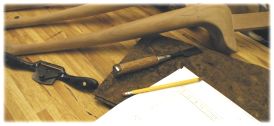 |
|
|
|
|
|
Part 1 |
With ordinary use, your vacuum bag will last for as long as you enjoy the art of veneering. Take care of the vacuum bag by storing it away from sources of UV such as sunlight and fluorescent lighting. It is also a good idea to avoid contact with strong solvents such as lacquer thinner. There are only two areas on the bag that may require periodic attention. The first is where the vacuum source attaches to the bag. Though it is very uncommon, leaks can develop at the seal between the lock-on connector and the stem fitting on the bag. The stem fitting is brass, which is a soft metal so it should be protected from gouging and crushing when the bag is not in use. The second area that often requires a bit of maintenance is at the open end of the bag where the closure is attached. Debris can stick to the bag material and allow vacuum to leak under the closure. Keep the inside and outside of the bag clean in the area where the closure is attached. It is also a good idea to occasionally apply a light coat of carnauba-based car wax to the outside of the bag where the closure is used. This will make it easier to attach and detach the C-channel part of the closure. Finding a Vacuum Leak To find the leak, insert the platen and breather mesh into the bag. Then slide some brown kraft paper, blue "shop" paper towels, or newspaper inside the bag near the bag opening and under the vacuum stem. Close the bag, attach the vacuum source to it, and then turn on the vacuum press. Allow the bag to develop as much vacuum as possible and then spray the bag stem and bag opening with water from a spray bottle. Any leaks in the bag will show up as the water is absorbed by the paper. If the leak is at the closure, you may need to clean the bag surfaces and/or place some spring clamps on the bag closure. If the leak is present between the lock-on connector and the bag stem, then you'll need to take a closer look at both parts. Make sure the top edge of the brass stem fitting on the bag is smooth and free of surface imperfections. This is the area that seals against the O-ring inside the lock-on connector. Replace the stem fitting if it is damaged. Peer inside the lock-on connector and make sure there is no debris stuck to the O-ring inside. You can use a small screwdriver to carefully remove the O-ring to clean it with water and then slide it back in place. Patching A Hole or Tear Vinyl patch kits used for repairing swimming pool liners can also work well for smaller areas in need of repair on vinyl bags. Unfortunately, pool patch kits do not work well on polyurethane bags. If you notice the leak while pressing a project panel and need a quick fix, just place some clear packing tape over the hole and press it down firmly. Note that this works far better on vinyl bags than ones made from polyurethane. For additional tips, please check out the Veneering FAQ.
|
|
|
|



